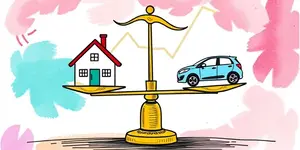Credit utilization is more than just a number on your statement—it’s a measure of how you manage debt and shape your financial future. By understanding and mastering this key factor, you can unlock opportunities for better interest rates, higher credit limits, and greater peace of mind.
Understanding Credit Utilization
Credit utilization ratio is the percentage of your total revolving credit that you’re currently using. It applies primarily to credit cards and other revolving lines of credit, such as personal lines of credit. Installment loans like mortgages and auto loans don’t factor into this calculation.
To calculate your credit utilization ratio, divide your total credit card balances by your total credit limits, then multiply by 100. For example, if you have two cards with a combined limit of $10,000 and a combined balance of $3,000, your ratio is (3,000 ÷ 10,000) × 100 = 30%. This figure is calculated both for each individual card and as an overall percentage across all cards.
Keeping an eye on both individual and total utilization is crucial—high utilization on a single card can harm your score even if your overall ratio is low. By monitoring monthly statement balances, you gain greater control over your credit profile.
Why Credit Utilization Matters
Credit utilization plays a pivotal role in major scoring models. In the FICO system, it accounts for 30% of your score—second only to payment history, which is 35%. VantageScore considers it 20% of the total. Lenders view low utilization as a sign of financial discipline, since it suggests you’re demonstrating responsible debt management and avoiding risky borrowing behavior.
Beyond the numbers, a strong utilization ratio can influence lender decisions on loan approvals and interest rates. Borrowers with consistently low usage often qualify for better terms, while those with high ratios may face higher costs or even rejection when seeking new credit.
Optimal Credit Utilization Levels
Industry experts generally recommend keeping utilization below 30% on each card and overall. However, data shows that top-scoring borrowers (720+) average about 10.2% utilization, while those with scores below 580 average around 75.7%. Although there’s no universal “perfect” ratio, the consensus is that lower (but not zero) utilization is optimal.
Zero utilization can signal inactivity, which fails to demonstrate your ability to manage credit. A small, manageable balance paid off each month hits the sweet spot: it shows you’re actively using credit without overextending. Focus on trends as well—paying attention to rising or falling utilization can help you stay ahead of potential score impacts in newer models like FICO 10T and VantageScore 4.0, which incorporate trend-based utilization analysis by credit models.
Impact on Your Credit Score
High credit utilization can significantly lower your credit score, as it signals potential financial stress to lenders. Conversely, low, consistent utilization helps build a strong credit profile, leading to greater borrowing power and lower interest rates.
In the latest scoring models, patterns in utilization over time carry weight. For instance, FICO 10T rewards those who consistently lower their usage month after month, rather than simply reacting to a single statement cycle. Understanding how your behavior is tracked and reported empowers you to take strategic action.
Practical Strategies to Optimize Your Ratio
Improving your credit utilization is both straightforward and impactful. By adopting proactive habits, you can see results within weeks, not years. Here are concrete steps to get you started:
- Pay down card balances before the statement closing date to report lower utilization.
- Spread purchases across multiple cards to avoid high utilization on a single account.
- Request a credit limit increase responsibly, maximizing your available credit wisely.
- Open a new credit card cautiously to boost available credit without adding debt.
- Set up automatic reminders to pay before statement dates for optimal reporting.
By combining these tactics, you’ll reduce your utilization ratio, strengthen your credit score, and open doors to better financial products. Even small shifts—like paying a balance down by a few hundred dollars—can move the needle on your score.
Embracing Healthy Financial Practices
Ultimately, credit utilization is a tool, not a burden. When managed thoughtfully, it becomes a reflection of building long-term financial resilience and discipline. Viewing your credit behavior as part of a broader financial journey helps you stay motivated and consistent.
As you master your ratio, you’ll find yourself empowering your financial future, whether you’re aiming to buy a home, secure a low-rate auto loan, or simply enjoy the peace of mind that comes with strong credit health. Each payment you make before your statement closing date, each responsible credit limit request, and each strategic purchase contributes to a more robust, reliable credit profile.
Remember, healthy credit habits don’t develop overnight—they’re the result of steady, intentional actions. By tracking your utilization, celebrating small wins, and adjusting tactics as needed, you build momentum toward lasting financial success.
Conclusion
Credit utilization is one of the most powerful levers you can pull to improve your credit score. By understanding how it’s calculated, why it matters, and the steps you can take to optimize it, you position yourself for better rates, greater approval odds, and long-term financial freedom. Start today by reviewing your most recent statements, planning targeted payments, and setting reminders. With each smart decision, you’ll be closer to the credit score you deserve.
References
- https://www.experian.com/blogs/ask-experian/credit-education/score-basics/credit-utilization-rate/
- https://www.equifax.com/personal/education/debt-management/articles/-/learn/credit-utilization-ratio/
- https://www.cbsnews.com/news/how-credit-utilization-affects-your-credit-score-and-what-to-do-about-it/
- https://www.pvfcu.org/how-credit-card-utilization-impacts-credit-score/
- https://www.bankrate.com/credit-cards/advice/credit-utilization-ratio/
- https://www.capitalone.com/learn-grow/money-management/credit-utilization-and-credit-score/
- https://www.lendingtree.com/credit-repair/credit-utilization-ratio/
- https://www.centier.com/resources/articles/article-details/how-does-credit-utilization-affect-your-credit-score










